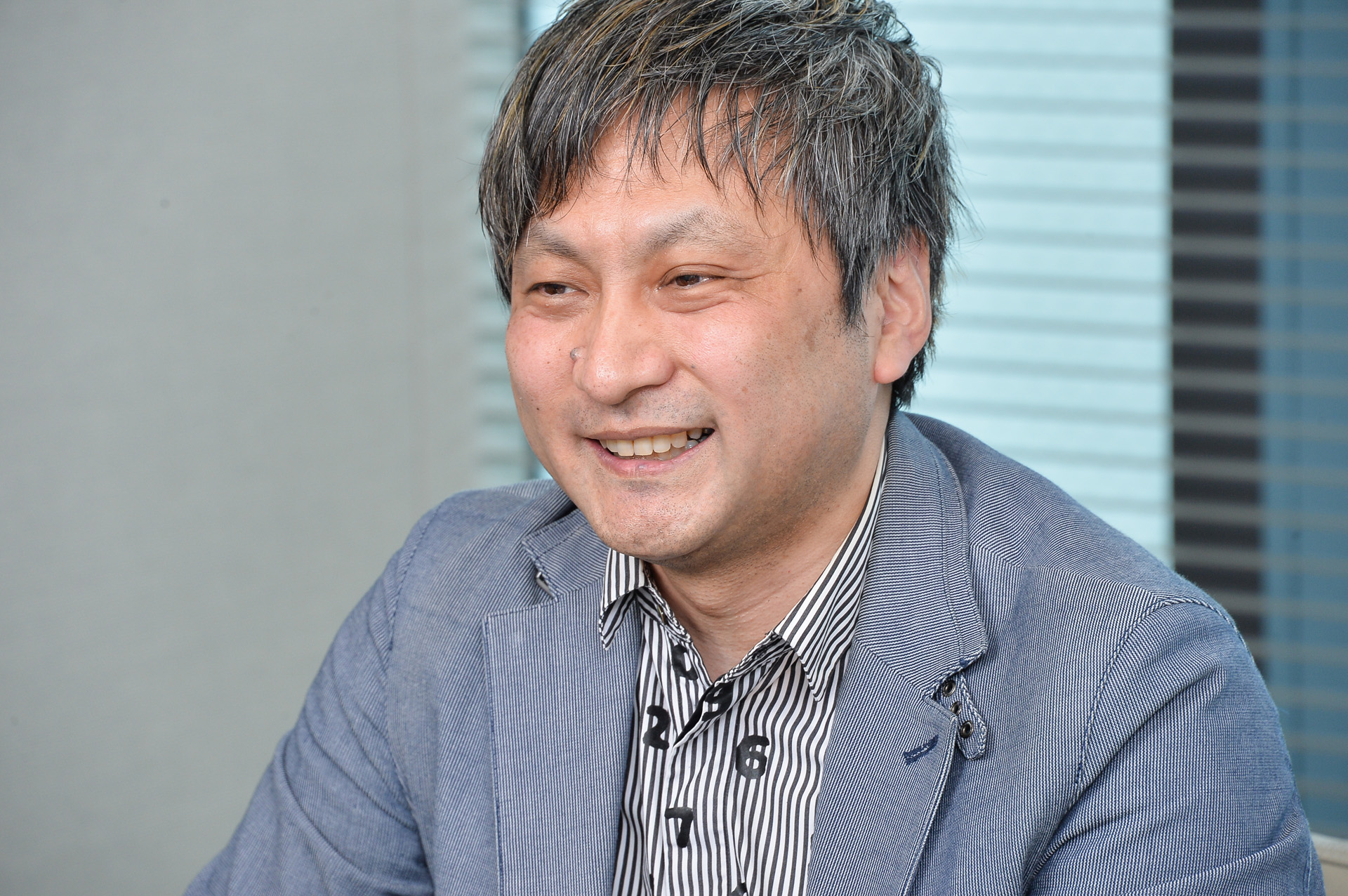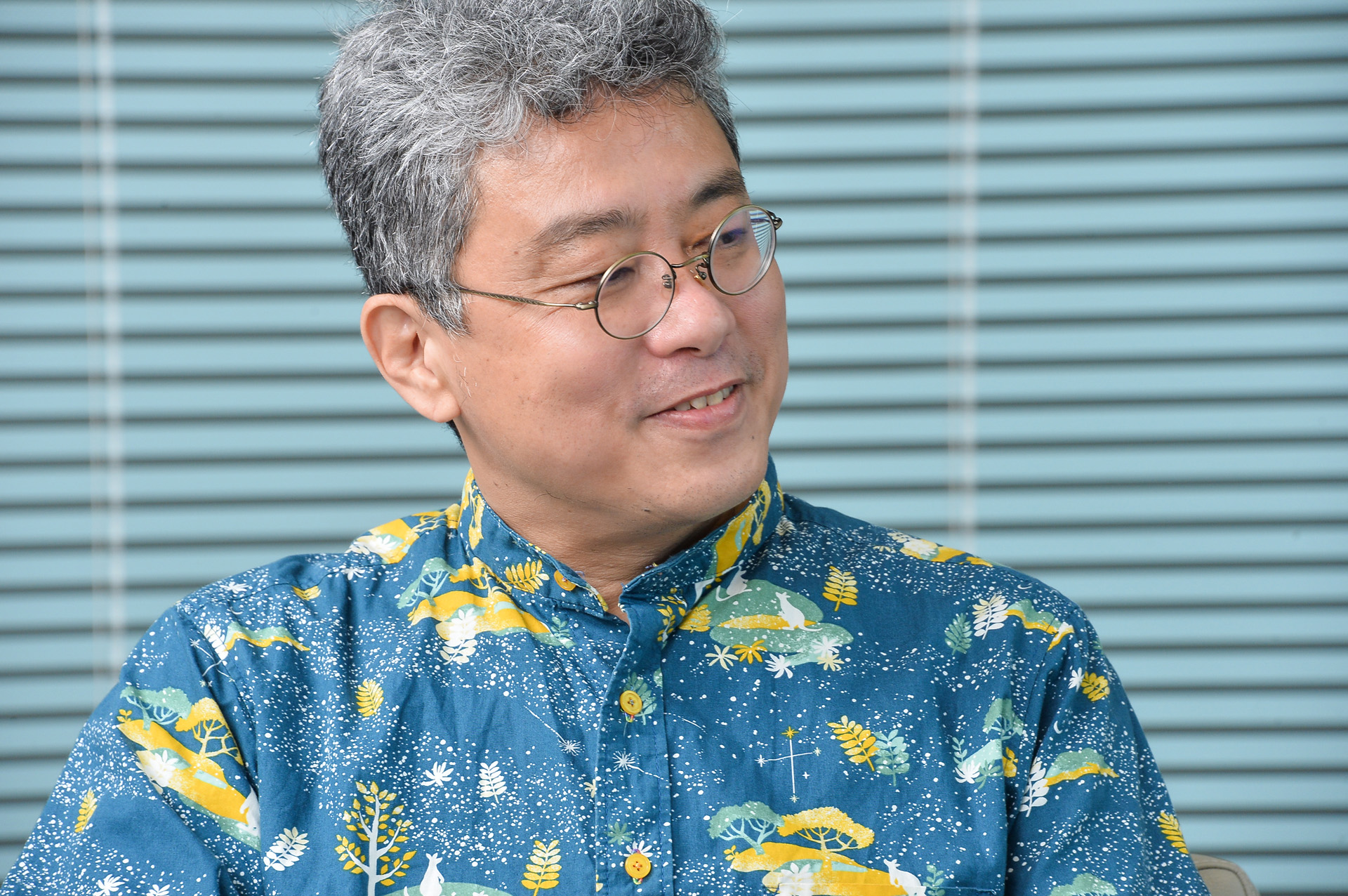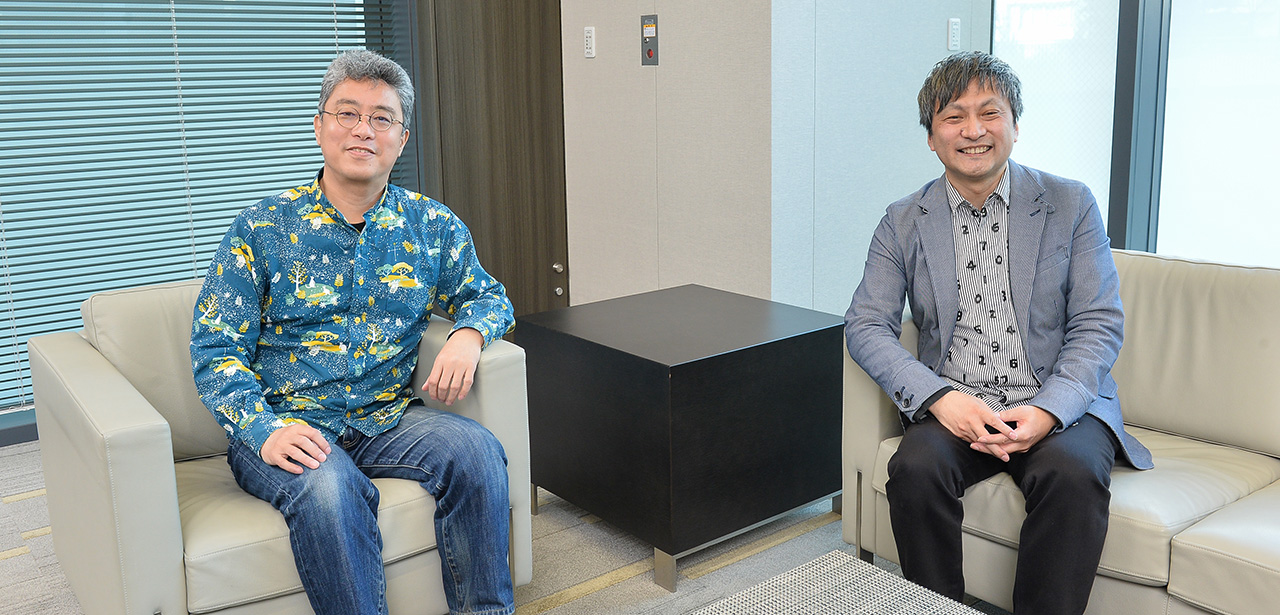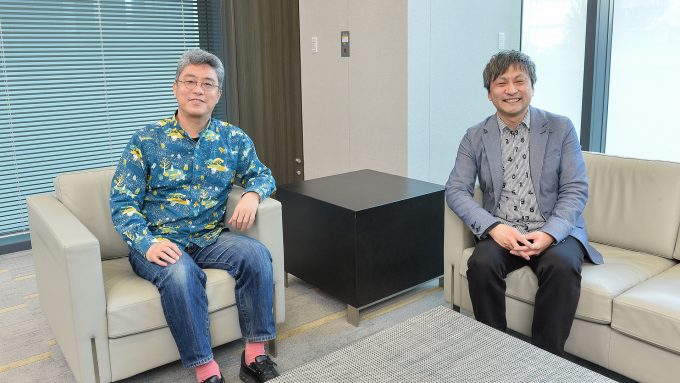“WE DISCUSS VANA’DIEL” is a series of conversations between Producer Matsui and special guests who are familiar with FINAL FANTASY XI (FFXI). Our thirteenth guest is Koji Aoyama, the original Director of PlayOnline (POL) and current Producer of the MMORPG DRAGON QUEST X Online (DQX Online). In this first part, Mr. Aoyama shared his initial experience with games and how he made his way into the world of programming.

Producer of DRAGON QUEST X Online. Following his departure from Hudson, he joined Square (now Square Enix) in 1999 and assumed the role of Director for PlayOnline. Mr. Aoyama then joined the DRAGON QUEST X Online development team as Technical Director and later succeeded Yosuke Saito as Producer in 2018.
Understanding machine code out of the blue
To start us off, could you tell us about your initial experience with games?
- Aoyama
My initial experience with computer games was playing TAITO’s Space Invaders* when I was in the sixth grade of elementary school*. My friends and I had heard about this amazing new game, so we flocked to what I believe was a café, to see what it was all about. Without even ordering a cup of coffee (laughs wryly), we inserted a 100-yen coin* into a machine and started playing, but it was game over for us in no time. I remember being shocked like, “I spent 100 yen and that’s all I get to play?” (laughs)
* Compulsory education in Japan consists of elementary school from first to sixth grade, then junior high school from seventh to ninth grade.
* Space Invaders is a fixed shooter game released by TAITO in 1978. It was the biggest hit in the history of arcade games and had an enormous influence on Japanese society, with game arcades springing up nationwide and cafés replacing their tables with arcade cabinets.
* 100 yen roughly equates to $1.00 (USD). - Matsui
100 yen was a lot of money to us when we were kids, wasn’t it?
- Aoyama
Boy, was I surprised. I couldn’t believe I’d spent 100 yen just for that. (laughs) I didn’t play Space Invaders much after that, but I was really into Galaxian* when I was in junior high. But looking back, I was terrible at the game.
* Galaxian is an arcade game released by Namco (now Bandai Namco Entertainment) in 1979. A fixed-screen shooter similar to Space Invaders, it gained popularity for its animated multi-color sprites and diverse sounds. I believe you were around for the NES craze; how did you feel about the NES?
- Aoyama
I was playing Western PC games before the NES was released. Shortly after that, DRAGON QUEST (DQ) on the NES became a social phenomenon, and since shooting games were all the rage at the time, I mistakenly wondered, “What kind of amazing shooting game is it?” (laughs)
- everyone
(laughs)
- Aoyama
I was later introduced to the series through DQIII*. I remember being impressed by how the game was enjoyable for all audiences and could even be cleared by anyone as long as they put in the time.
* DRAGON QUEST III: The Seeds of Salvation is an RPG for the NES released by Enix (now Square Enix) in 1988. The game introduced features such as character customization, recruitable party members, and changing classes, and was a major hit that became a social phenomenon in Japan. - Matsui
What did you think of the first and second entries in the DQ series?
- Aoyama
Since I’d finally started the series from DQIII, I was a bit late to the DQ craze. Like I mentioned earlier, PC games were the main thing for me back then, which I played on the computers at school or at my friends’ houses. As for my personal computer, I owned a X68000*.
* The X68000 is a home computer released by Sharp in 1987. It was exclusively sold in Japan, where it was the only PC which used a Motorola-based CPU, the MC68000. - Matsui
Ah, programmers loved that model. I owned a PC-88*. What I’d really wanted was a PC-98*, but the price was on another level…
* PC-88 refers to the PC-8800 series of Japanese computers released by Nippon Electric Company (NEC) in 1981. The PC-8801mkII and PC-8801mkIISR models were particularly popular as hobby PCs and had numerous games released for them.
* PC-98 refers to the PC-9800 series of Japanese computers released by NEC in 1982. They were initially released as business-oriented PCs, but numerous games were released for them in the late 1980s and 1990s. You have quite the interesting background in video games. What was it that made you decide to become a game developer?
- Aoyama
During my second year in junior high, a classmate suddenly approached me about these amazing things called “computers.” As I listened to his fervent enthusiasm of CPUs and circuits, I grew interested in the subject as well.
From there, without any knowledge whatsoever, we somehow decided that he’d learn about the hardware side of things, while I’d learn about software, and so I began studying. But when I purchased books to learn about machine code, they were gibberish to me and I couldn’t understand them at all.
I just wasn’t getting anywhere. - Matsui
Was there a turning point after that?
- Aoyama
It happened about six months after we started. There’s this manga called “Glass Mask” where the protagonist’s rival actress is performing in a play. Someone in the audience realizes she’s playing the role of Helen Keller and exclaims, “It was like being struck by lightning…” That’s exactly how it came to me.
- Matsui
What kind of metaphor is that? (laughs)
- Aoyama
That’s what it was like though! (laughs) One day, I suddenly understood machine code out of the blue, as if I were struck by lightning. It filled me with a sense of omnipotence, and I felt like I could take on the world. That was in autumn of my second year in junior high.

- Matsui
That’s quite amazing. Since you were in junior high, that would’ve been when the MZ-80B* was on the market.
* The MZ-80B is a personal computer released by Sharp in 1981. It features an "all-in-one design" which integrates a keyboard, monochrome display, and cassette deck for reading and writing data into the main unit. - Aoyama
I’m not sure, was it already out? Either way, back when I couldn’t understand programming, I was always just sitting at my desk; whereas once I was able to program, I frequented the local PC store where they graciously allowed me to freely use the PCs on display. I believe it was the MZ-80K* on sale around then. But you sure know your stuff, Mr. Matsui. (laughs)
* The MZ-80K is a series of personal computers released by Sharp in 1978 and the first of Sharp’s MZ-80 models. - Matsui
It’s because I was studying BASIC* at the time. I enjoyed reading “Mycom BASIC Magazine” and other publications on the subject.
* BASIC is a general-purpose programming language designed for ease of use.
* "Mycom BASIC Magazine" is a PC hobby magazine published between 1982 and 2003 by Denpa Shinbunsha, known for publishing a list of reader-submitted programs for various computer models. Mr. Matsui, did you also have a sort of trigger that opened your eyes to programming, like Mr. Aoyama did?
- Matsui
When I entered high school, my chemistry teacher told me to buy a pocket computer or a scientific calculator, their point being that doing all the calculations myself would take too much time. Heeding the advice, I purchased a programmable Casio scientific calculator and started learning BASIC, and that was my introduction to programming. Since I started with BASIC, at first, I couldn’t understand machine code at all.

- Aoyama
Anyone who’s familiar with programming would know that “A=1” means that “A” is a data variable with a value of 1. In machine code, however, it would be written in hexadecimal, as "3E01.” That’s just how machine code is, so you can’t learn it unless you sit down and really try to comprehend it. In that sense, it was probably a good thing that I learned machine code first. (laughs)
- Matsui
You described it as "being struck by lightning"; does that mean the bits and pieces you had in your head for half a year suddenly snapped together?
- Aoyama
Yes, it was like all of it came together at once. There’s a famous book titled "A Technique for Producing Ideas,”* which explains that your mind reorganizes information while you sleep, so you can understand things better and come up with good ideas if you go to bed after absorbing information. It’s probably the same idea, except it took half a year in my case.
* “A Technique for Producing Ideas” is a book written by American businessman James Webb Young in 1940. After you understood machine code, what led you to choose game development over other career choices in the computer industry?
- Aoyama
When I entered university, I majored in artificial intelligence (AI). It’s said that we’re currently going through the “third wave of AI,” whereas back then was considered the “second wave,” and the term “fuzzy logic” was a popular phrase. Most people in AI research labs go on to graduate school, but I wanted to create consumer products rather than study for research's sake, so that was my goal for the future. When I thought about what I wanted to create, naturally I thought of the games I’d been making since junior high. Having been impressed by DQIII when I was in college also proved influential, and so I thought, “Making games is what I’m best at, I’m sure it’ll be fun,” and chose the path of game development.
* “Fuzzy logic” is a method of reasoning which imitates the ambiguity of human decision-making, where the true value of a variable may be any real number between 0 and 1. - Matsui
Oh, so you were already making games when you were still in school.
- Aoyama
Yes, I was. Back when I was in junior high, PCs still didn’t have much in the way of graphical capabilities, so I made a “dot-eating” game similar to Pac-Man using only symbols. As the graphical capabilities of computers improved, I made a game where you navigate through outer space by controlling the acceleration of your character to avoid obstacles. Although I could clear the game without making any mistakes, when I had my friends play it, they couldn’t clear it at all. That was my early experience of a common game development phenomenon: the developer puts so much time into their game that they’re no longer able to correctly gauge its difficulty level. I thought it was a well-made game at the time, but looking back now, it was no good. (laughs)
- Matsui
I guess you were faced with one of the “cardinal truths” of game production at an early age. (laughs)
Aspirations and joining Hudson in Sapporo
After graduating from college, you went on to work at Hudson. Could you tell us about what made you choose to work there?
- Aoyama
It goes back to the X68000 I mentioned earlier, but Hudson was the company that made the OS for the X68000*. I was attracted to their technical prowess and the fact they made the OS that I liked, so I went from Tokyo to Sapporo for an interview. In the end, they replied, “Okay, come join us,” and I was able to join the company with relative ease.
* The Human68k OS for the X68000 was co-developed by Sharp and Hudson. Hudson certainly had a lot of momentum on the NES and PC engines.
- Aoyama
They sure did. Although Hudson certainly stood out to me for those reasons, I wasn’t really looking for a job at a well-known company; in fact, for whatever reason, I was really confident that I just needed to find a place that would hire me, and that the rest would take care of itself. Of course, when I started working, I found myself lacking in many aspects… (laughs wryly)
- Matsui
You mentioned being impressed by DQIII; did you ever consider working at Enix (now Square Enix) or other companies related to DQ?
- Aoyama
I wasn’t all that fixated on DQ. Since I played TRPGs*, I wanted to create a computer RPG someday, but I never imagined I’d become a staff member for DQ. I was more interested in creating my own original RPG.
* Tabletop role-playing games (TRPGs) are role-playing games that progress based on a rulebook and spoken events. In Japan, these are often referred to as “table-talk role-playing games” instead. Do you have any memorable stories from your time at Hudson?
- Aoyama
I was actually the one who programmed the original "King Bonbii."* Massive characters like “King Bonbii” are nothing special nowadays, but back then, objects were displayed with 16x16 pixel sprites and it was a struggle just to display a large character.
* “King Bonbii” is a nefarious recurring character in the Momotaro Dentetsu series who mercilessly sabotages players. The character debuted in Super Momotaro Dentetsu II, released in 1991 by Hudson for PC engines.
On top of that, we had to show ten dice being rolled as part of the visual effects. Since those dice were also displayed with sprites, we hit the limit of how many objects that could be simultaneously displayed. We had to get really creative; sequentially hiding some of the dice made them look translucent, so we used that and other tricks to decrease the number of objects being displayed at once. - Matsui
I had no idea that you were involved with that infamous character. (laughs) Speaking of Hudson, the enemy characters in the Bomberman series were quite famous for their superb AI. Did studying AI at university come in handy in your work?
- Aoyama
It did come in handy to some extent, but at the end of the day, what I learned in school was merely the theory of AI. For example, I was in charge of programming Super Bomberman 3, but it was impossible to simply implement something that could be considered AI within the SNES’s specifications.
With that said, I feel that I did a good job with creating the enemy behaviors in Super Bomberman 3. Modern game consoles are capable of multi-tasking and parallel processing, but game consoles at the time were only capable of single-tasking. This meant enemy characters only had a single frame to “think” while the display was refreshed at 60 frames per second, but that wasn’t anywhere near enough time to process something like AI. So instead, the process of deciding an action was divided into several segments so that one part of the behavior was handled during a particular frame, then the next part of the behavior was handled in the frame after that, and so on, until a final conclusion was reached and the game reflected the actual action several frames later.




